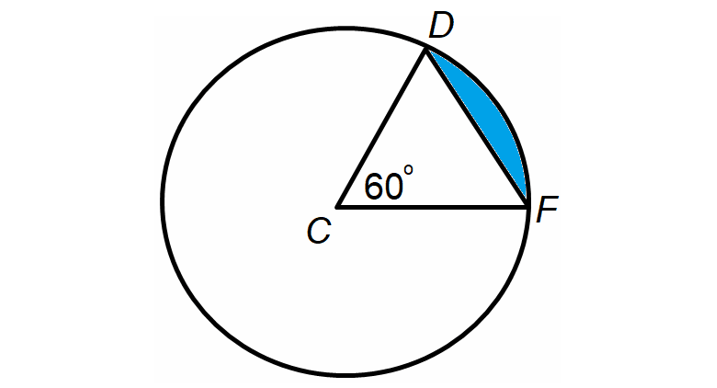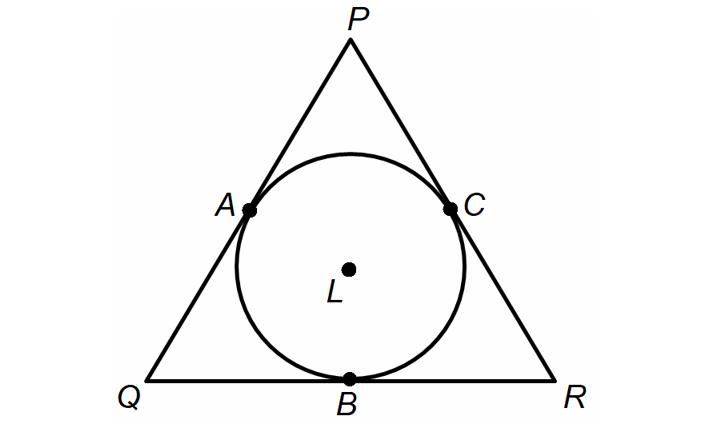HOW TO SOLVE RATIONAL INEQUALITIES
How to solve rational inequalities ?
The General forms of rational inequalities are below :
ü P(x)/Q(x) < 0
ü P(x)/Q(x) > 0
ü P(x)/Q(x) ≤ 0
ü P(x)/Q(x) ≥ 0
which is one of the forms of a given questions.
Step 1 :
By equate the numerator P(x) = 0 and denominator Q(x) = 0
Step 2 :
We solved the x values from step 1. These values are known as critical numbers.
Step 3 :
By applying these x values on a number line, we find the intervals.
Step 4 :
We will choose random values from intervals and apply the given function.
If f(x) is being satisfied by the values what we choose from the interval, then that particular interval or intervals are known as solution.
Solve for x :
Example 1 :
(x + 2)/(x – 3) < 0
Solution :
Let f(x) = (x + 2)/(x – 3)
f(x) < 0
(x + 2)/(x – 3) < 0
By equating the numerator and denominator to zero, we get
x + 2 = 0, x – 3 = 0
x = -2 and x = 3 (critical numbers)
The critical numbers are dividing the number line into three intervals.
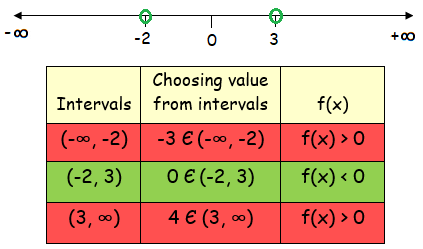
From the table, the possible values of x are
-2 < x < 3
By writing it as interval notation, we get
(-2, 3)
So, the required solution is -2 < x < 3
Example 2 :
(x + 3)/(2 – x) < 0
Solution :
Let f(x) = (x + 3)/(2 – x)
f(x) < 0
(x + 3)/(2 – x) < 0
By equating the numerator and denominator to zero, we get
x + 3 = 0, 2 – x = 0
x = -3 and x = 2 (critical numbers)
The critical numbers are dividing the number line into three intervals.
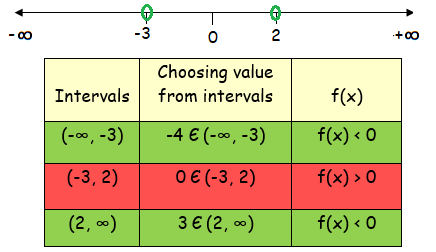
From the table, the possible values of x are
x < -3 or x > 2
By writing it as interval notation, we get
(-∞, -3) u (2, ∞)
So, the required solution is x < -3 or x > 2
Example 3 :
(x - 1)/(x + 3) ≥ -1
Solution :
Let f(x) = (x - 1)/(x + 3)
f(x) ≥ -1
(x - 1)/(x + 3) ≥ -1
Add 1 on both sides, we get
(x - 1)/(x + 3) + 1 ≥ -1 + 1
Taking least common multiple, we get
[(x – 1) + (x + 3)]/(x + 3) ≥ 0
(x - 1 + x + 3)/(x + 3) ≥ 0
(2x + 2)/(x + 3) ≥ 0
By equating the numerator and denominator to zero, we get
2x + 2 = 0, x + 3 = 0
x = -1 and x = -3 (critical numbers)
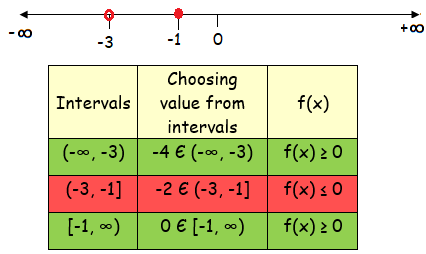
From the table, the possible values of x are
x < -3 or x ≥ -1
By writing it as interval notation, we get
(-∞, -3) u [-1, ∞)
So, the required solution is x < -3 or x ≥ -1
Example 4 :
(x + 2)/(2x - 3) < 1
Solution :
(x + 2)/(2x - 3) < 1
Subtract 1 on both sides, we get
(x + 2)/(2x - 3) - 1 < 1 – 1
(x + 2)/(2x - 3) - 1 < 0
Taking least common multiple, we get
[(x + 2) + (-2x + 3)]/(2x - 3) < 0
(x + 2 - 2x + 3)/(2x - 3) < 0
-(x - 5)/(2x - 3) < 0
Make a coefficient x as positive, so we have to multiply by -1 through out the equation,
(x - 5)/(2x - 3) > 0
By equating the numerator and denominator to zero, we get
x - 5 = 0, 2x - 3 = 0
x = 5 and x = 3/2 (critical numbers)
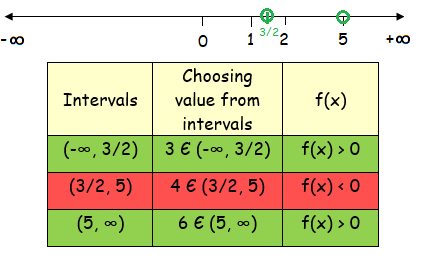
From the table, the possible values of x are
x < 3/2 or x > 5
By writing it as interval notation, we get
(-∞, 3/2) u (5, ∞)
So, the required solution is x < 3/2 or x > 5
Example 5 :
(5 – 2x)/(1 - x) > 4
Solution :
(5 – 2x)/(1 - x) > 4
Subtract 4 on both sides, we get
(5 – 2x)/(1 - x) - 4 > 4 – 4
(5 – 2x)/(1 - x) - 4 > 0
Taking least common multiple, we get
[(5 – 2x) - 4(1 - x)]/(1 - x) > 0
(5 – 2x - 4 + 4x)/(1 - x) > 0
(2x + 1)/(1 - x) > 0
By equating the numerator and denominator to zero, we get
2x + 1 = 0, 1 - x = 0
x = -1/2 and x = 1 (critical numbers)
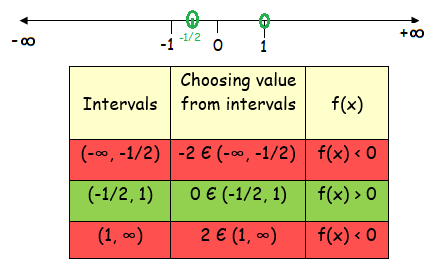
From the table, the possible values of x are
-1/2 < x < 1
By writing it as interval notation, we get
(-1/2, 1)
So, the required solution is -1/2 < x < 1
Example 6 :
4/x ≤ x
Solution :
4/x ≤ x
Subtract x on both sides, we get
4/x – x ≤ x – x
4/x – x ≤ 0
(4 – x2)/x ≤ 0
By equating the numerator and denominator to zero, we get
4 – x2 = 0, x = 0
x = ±2, x = 0
so, x = 2, x = -2 and x = 0
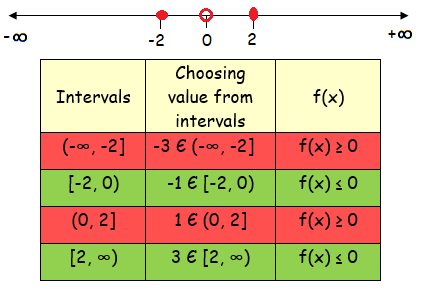
From the table, the possible values of x are
-2 ≤ x < 0 or x ≥ 2
By writing it as interval notation, we get
[-2, 0) u [2, ∞)
So, the required solution is -2 ≤ x < 0 or x ≥ 2
Example 7 :
3/x > 2/(x + 2)
Solution :
3/x > 2/(x + 2)
Subtract 2/(x + 2) on both sides, we get
3/x – 2/(x + 2) > 2/(x + 2) - 2/(x + 2)
3/x – 2/(x + 2) > 0
Taking least common multiple, we get
[3(x + 2) – 2(x)]/x(x + 2) > 0
[3x + 6 – 2x]/x(x + 2) > 0
(x + 6)/x(x + 2) > 0
By equating the numerator and denominator to zero, we get
x + 6 = 0, x(x + 2) = 0
so, x = -6, x = 0 and x = -2
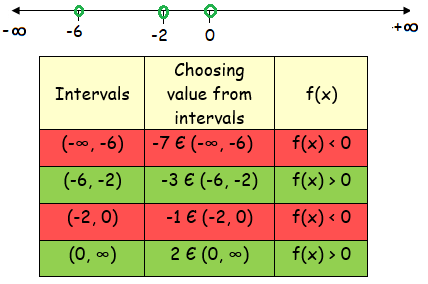
From the table, the possible values of x are
-6 < x < -2 or x > 0
By writing it as interval notation, we get
(-6, -2) u (0, ∞)
So, the required solution is -6 < x < -2 or x > 0
Example 8 :
x/(x + 6) > 3/x
Solution :
x/(x + 6) > 3/x
Subtract 3/x on both sides, we get
x/(x + 6) – 3/x > 3/x – 3/x
x/(x + 6) – 3/x > 0
Taking least common multiple, we get
[x2 – 3(x + 6)]/x(x + 6) > 0
[x2 – 3x – 18]/x(x + 6) > 0
By factorization, we get
(x – 6) (x + 3)/x(x + 6) > 0
By equating the numerator and denominator to zero, we get
x - 6 = 0, x + 3 = 0 and x(x + 6) = 0
So, x = 6, x = -3, x = 0 and x = -6
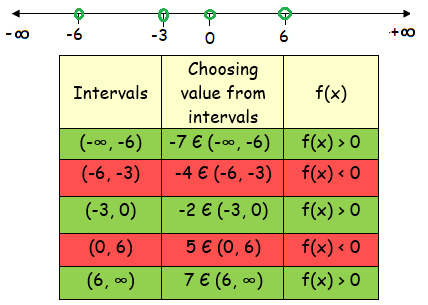
From the table, the possible values of x are
x < -6 or -3 < x < 0 or x > 6
By writing it as interval notation, we get
(-∞, -6) u (-3, 0) u (6, ∞)
So, the required solution is x < -6 or -3 < x < 0 or x > 6
Kindly mail your feedback to v4formath@gmail.com
We always appreciate your feedback.
©All rights reserved. onlinemath4all.com
Recent Articles
-
Digital SAT Math Problems and Solutions (Part - 271)
Aug 31, 25 07:25 AM
Digital SAT Math Problems and Solutions (Part - 271) -
Digital SAT Math Problems and Solutions (part - 270)
Aug 30, 25 04:19 AM
Digital SAT Math Problems and Solutions (part - 270) -
Digital SAT Math Problems and Solutions (Part - 269)
Aug 28, 25 09:59 PM
Digital SAT Math Problems and Solutions (Part - 269)
